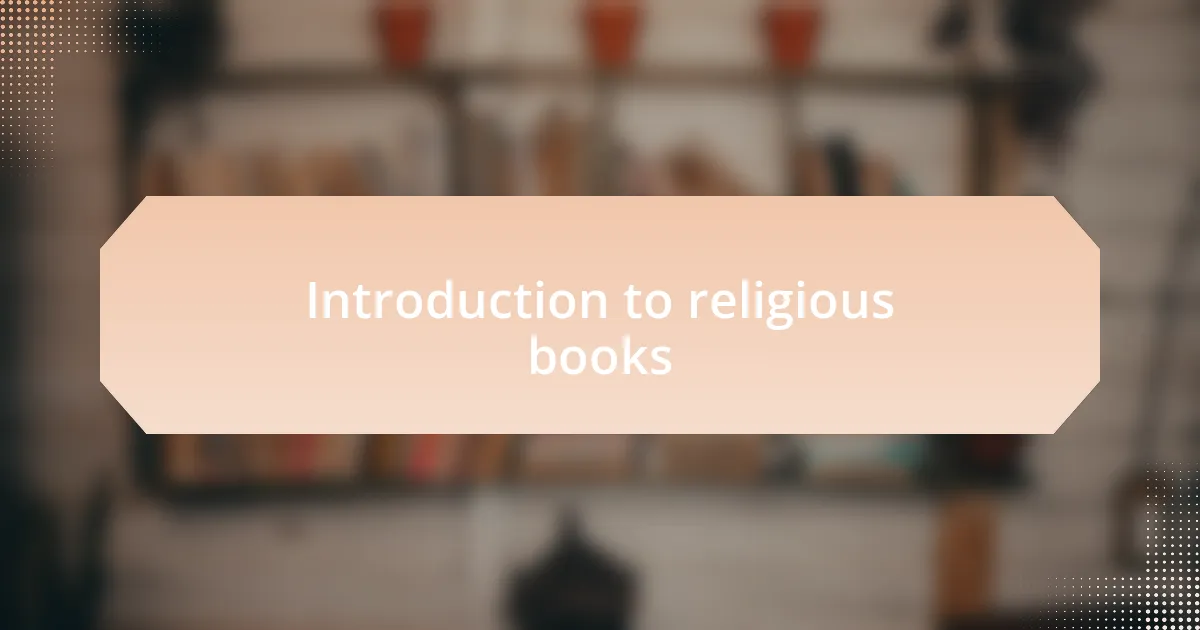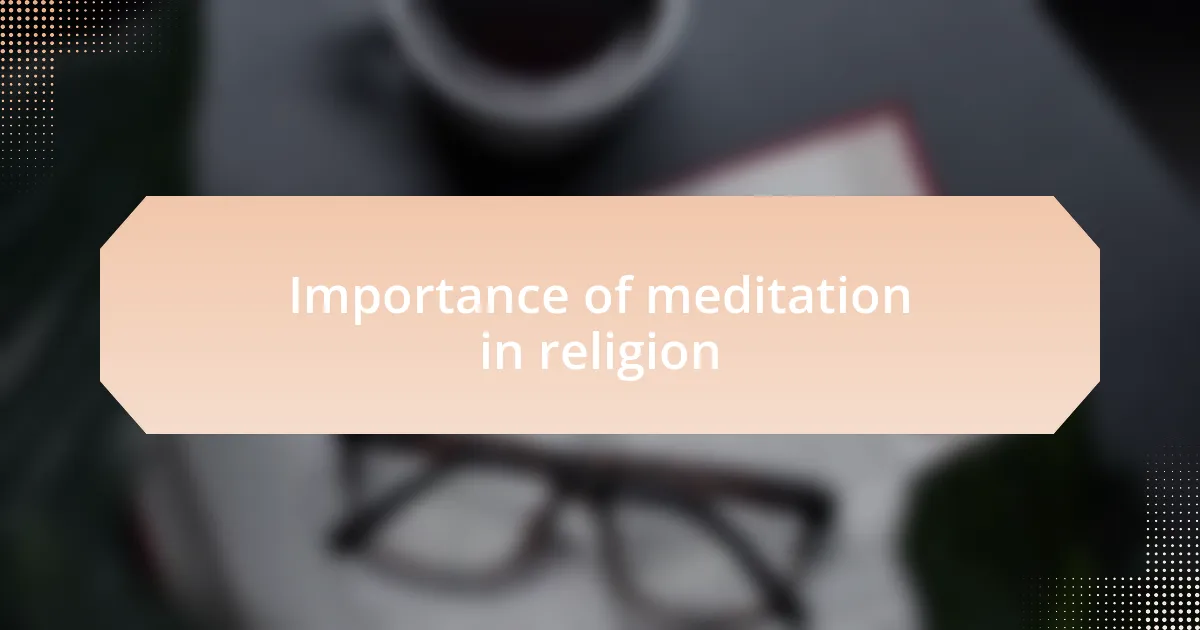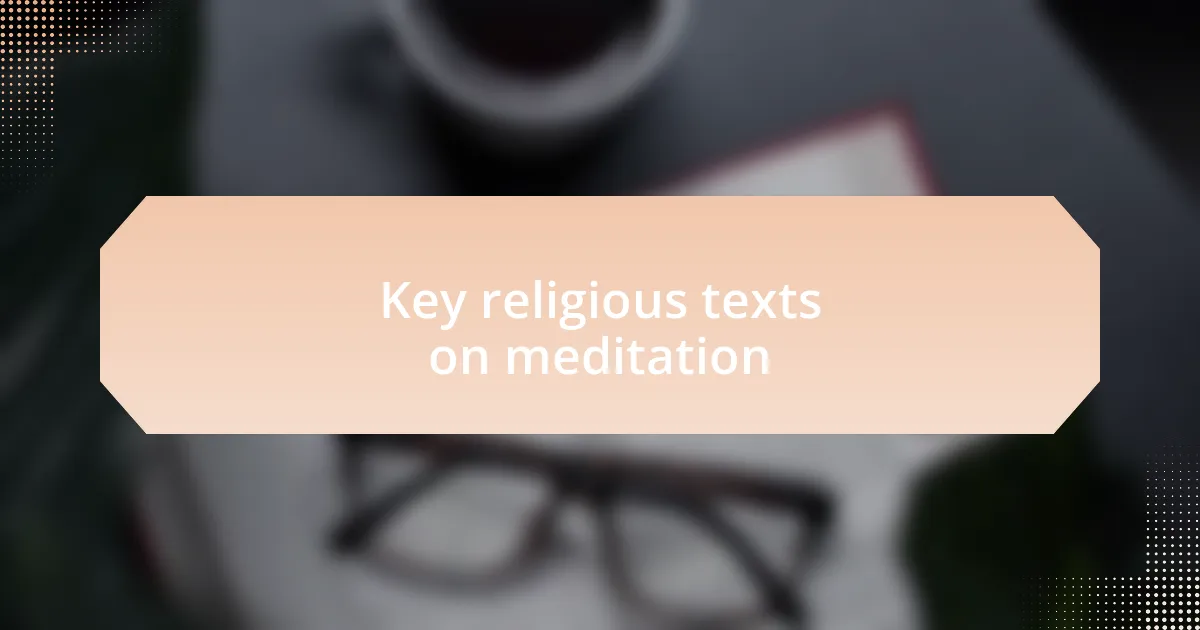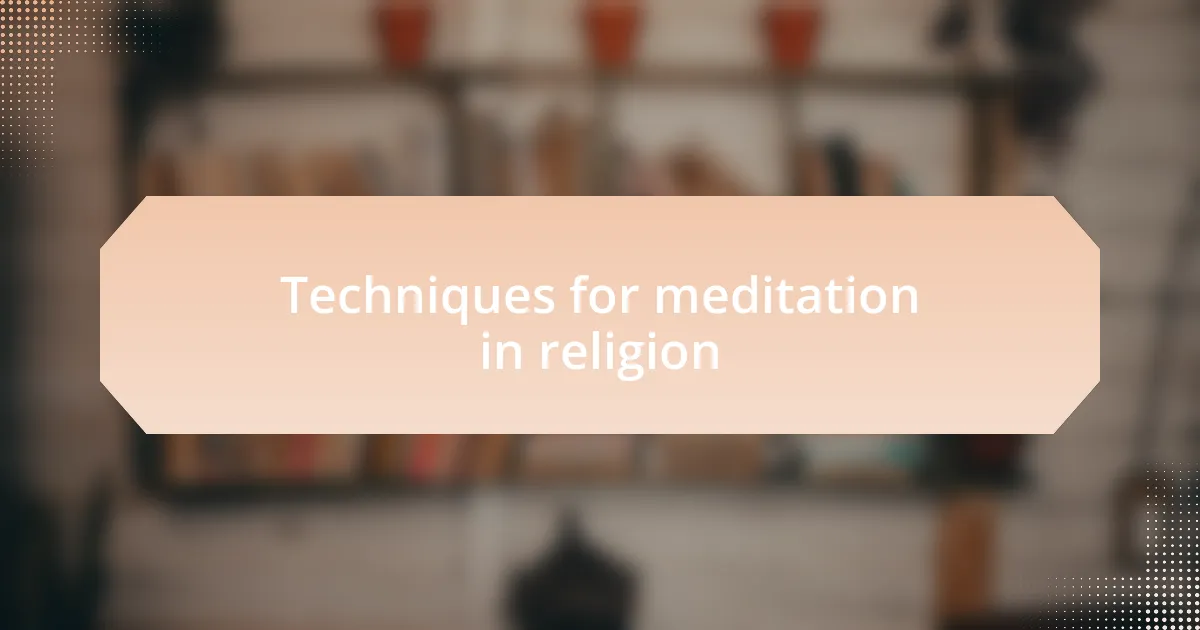Key takeaways:
- Religious books provide wisdom and moral teachings, shaping spiritual journeys and fostering a shared quest for meaning.
- Meditation is fundamental in many religions, enhancing understanding and connection to the divine while promoting inner peace and mindfulness.
- Key religious texts, such as the Bhagavad Gita and Psalms, guide meditation practices and resonate with personal experiences, revealing universal significance across faiths.
- Integrating meditation into daily life can be achieved through simple mindfulness practices, enriching overall well-being and cultivating awareness in everyday activities.

Introduction to religious books
Religious books serve as sacred texts that capture human experiences with the divine. They guide countless individuals in their spiritual journeys, offering wisdom, rituals, and moral teachings. When I first opened a religious book, I remember feeling an overwhelming connection to something greater than myself—like a bridge across time and culture.
Different traditions have their own texts, each rich with history and significance. Have you ever wondered how a single book can shape entire civilizations? I have found that exploring these diverse scriptures not only deepens my understanding of faith but also enriches my appreciation for humanity’s shared quest for meaning.
As we delve into the world of religious literature, it’s fascinating to see how these texts address life’s fundamental questions. I often discover new insights that resonate with my personal experiences, prompting me to reflect on my own beliefs. The stories, prayers, and teachings within these pages can be transformative, guiding us in self-discovery and spiritual growth.

Importance of meditation in religion
Meditation plays a pivotal role in many religions, often serving as a pathway to deeper understanding and connection with the divine. I find that it creates a quiet space where thoughts can settle, allowing me to hear the subtle whispers of spiritual guidance. Have you ever felt more in touch with your beliefs during a moment of stillness? These moments of reflection can reveal profound insights and foster a greater sense of inner peace.
In various traditions, meditation is not just a practice but a sacred ritual that enhances spiritual discipline. For example, I remember my first encounter with Buddhist meditation; it was like stepping into a serene world where the chaos of daily life faded away. The structured breathing and focus on the present transformed my understanding of mindfulness, allowing me to appreciate each moment more deeply. Isn’t it fascinating how such practices can alter our perception of time and existence?
Furthermore, the communal aspect of meditation cannot be overlooked. Participating in group meditations often amplifies the experience, creating a collective energy that is both uplifting and grounding. I’ve noticed that sharing a space with others who are equally seeking spiritual depth fills me with a sense of belonging. How does participating in such practices impact your spiritual journey? Through this shared silence, we collectively nurture our souls, reinforcing the importance of community in our spiritual lives.

Key religious texts on meditation
Key religious texts on meditation
Many religious texts provide guidance on meditation, each reflecting the unique beliefs and practices of their traditions. For instance, in the Bhagavad Gita, meditation is described as a key to achieving tranquility and self-realization. I often find myself revisiting these verses when I need inspiration to center my thoughts. Have you ever drawn wisdom from ancient words that resonate with your current experiences?
The Dhammapada, a collection of sayings from the Buddha, emphasizes mindfulness and the importance of mental discipline. I can still recall the first time I read it; the verses felt like gentle nudges towards awareness in my daily life. Isn’t it interesting how ancient teachings can still feel so relevant and applicable today?
In Christianity, texts such as the Psalms provide a framework for meditative prayer, allowing believers to connect with God through reflection and contemplation. This practice has been transformative for me, creating a space for gratitude and introspection. How often do we take the time to pause and meditate on what we are thankful for? Exploring these texts opens a window into how diverse cultures approach meditation, revealing its universal significance across different faiths.

Personal experiences with meditation
Meditation became a significant part of my daily routine during a challenging time in my life. I remember sitting cross-legged on my bedroom floor, guided by calming chants from a favorite spiritual app. With each breath, I found solace in the present moment, a refreshing contrast to the anxiety that often filled my mind. Has meditation ever led you to a place of unexpected peace?
One evening, while practicing a form of guided meditation from a religious text, I felt an overwhelming sense of connectedness. It was as if my worries dissolved, and I was part of something larger—an universal energy binding us all together. This profound experience made me ponder how meditation can deepen our understanding of faith and community. Can we truly grasp the divine without moments of stillness?
Interestingly, I have noticed that my approach to meditation often shifts with my spiritual journey. Certain techniques resonate more deeply during specific periods in my life. For instance, during times of doubt, I gravitate towards contemplative prayer, allowing me to process my emotions and reconnect with my beliefs. Have you experienced similar shifts in your meditation practice, guided by your spiritual growth?

Techniques for meditation in religion
Meditation in religious contexts often varies in technique, reflecting the unique traditions and beliefs within each faith. For instance, in Buddhism, mindfulness meditation emphasizes present-moment awareness, often enhanced by focusing on the breath. I once attended a retreat where we were guided to observe our thoughts without judgment, which led me to a striking realization about how often we cling to negative patterns. Have you ever taken a moment just to observe your thoughts without reacting?
In contrast, many Christian practices incorporate contemplative meditation through lectio divina, where scripture passages are read slowly and thoughtfully. I recall a time when I sat quietly with a particular verse that resonated deeply with my current struggles. By allowing the words to wash over me, I found a new perspective that brought clarity and reassurance. Could there be a single line in a sacred text that might just change your outlook entirely?
Similarly, in Hinduism, mantra meditation serves as a powerful technique. Repeating sacred phrases creates a rhythm that aligns the mind and spirit. I remember my first experience chanting with a group; the vibrations created a shared sense of peace that was almost tangible. Have you felt how collective energy can amplify personal spiritual practices? These techniques, rooted in religious traditions, not only foster individual clarity but create a deeper connection to a larger community.

Integrating meditation into daily life
Incorporating meditation into daily life can feel daunting, but I’ve found that even a few minutes of mindfulness can make a tremendous difference. For instance, I began setting aside just five minutes each morning. During this time, I focused on my breath while also offering gratitude for a new day. It’s amazing how these simple moments have transformed my perspective, leaving me more grounded and ready to face whatever comes my way. Have you considered how a brief pause in your hectic routine might affect your mood?
I’ve noticed that integrating meditation doesn’t have to be a formal practice. I often meditate while walking, especially in nature. With each step, I consciously take in my surroundings—the sound of leaves rustling, the scent of the earth after rain—and it feels like a moving meditation. This blend of activity and mindfulness brings a refreshing clarity that’s hard to replicate when sitting still. Could you find similar ways to engage with the world around you while cultivating your inner space?
Sometimes, I find that the stillness of meditation can unexpectedly arise during mundane tasks, like washing the dishes or commuting. I turn those moments into a mini-retreat by focusing solely on the rhythm of my actions. Letting go of distractions allows me to reconnect with myself in unexpected places. How often do we overlook these pockets of time that can nurture our spirit? By training ourselves to find moments of meditation throughout our day, we enrich our lives with peace and awareness, no matter how busy life gets.

Resources for further exploration
Exploring further resources on meditation within religious contexts can enhance your practice significantly. I stumbled upon several insightful books, such as “The Miracle of Mindfulness” by Thich Nhat Hanh, which beautifully combines meditation with spiritual teachings. Have you ever found a resource that resonated so deeply it changed how you view your practice? For me, that was a game changer.
Online courses and workshops can also offer a structured way to deepen your understanding. I took part in a virtual retreat that guided participants in blending meditation with religious narratives. It sparked a profound realization in me about the universal threads of compassion that weave through various faiths. What if dedicating a weekend to such an experience could open your heart in unexpected ways?
Additionally, various apps now curate meditation practices inspired by diverse religious traditions. I’ve been using one that features meditative chants, introducing me to sacred sounds I hadn’t encountered before. Have you ever considered how music can elevate your meditation experience? It’s incredible how these tools can offer fresh perspectives and enrich the journey of melding meditation with faith.